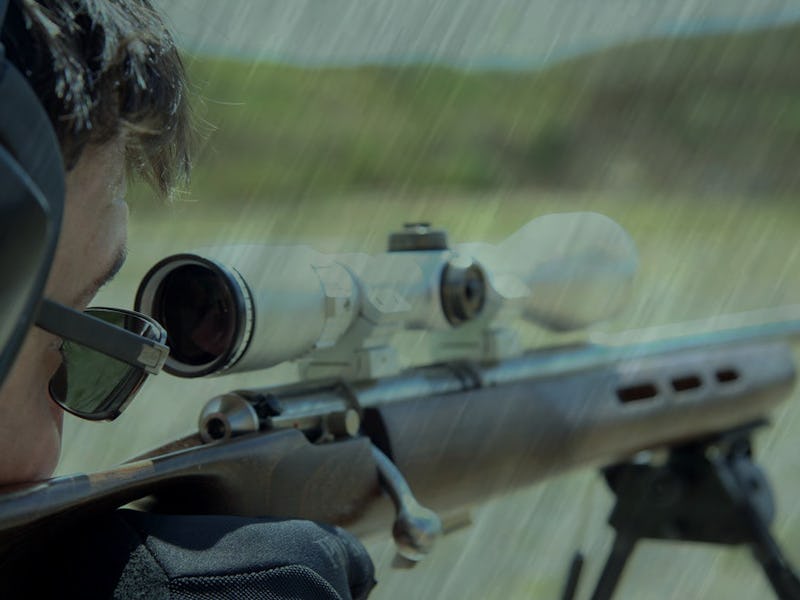What Would Actually Happen if You Shot a Gun at Hurricane Florence?
Storm winds can shift a bullet's path more than you think.

Hurricane Florence, which is currently making landfall, may be unique in its predicted intensity and historic path, but in one major way, it’s just like every other hurricane. You still can’t stop it by shooting it with a gun. The warning tweeted by the Coalition to Stop Gun Violence one year ago, in September 2017, was simple: “DO NOT SHOOT YOUR GUNS AT THE HURRICANE!!!” Unfortunately, some arms-bearing Americans had gotten the idea that doing so might stop Hurricane Irma from advancing into Florida, and the warning was necessary.
And whether people really think it’s possible to stop a hurricane with a mouthful of lead or they’re just trying too hard to make this whole absurd joke go viral again, the hurricane shooters have logged on for Hurricane Florence.
For your safety and the safety of your neighbors, read this whole article before you aim your rifle, handgun, or pistol-grip semiautomatic rifle with a large-capacity magazine and telescoping stock at a hurricane and squeeze off a handful of rounds. If you shoot any bullet into a hurricane, it will travel fast enough to kill someone, but its trajectory will be blown way off course, making it nearly impossible to predict where it will land.
It will, inevitably, hit something or someone.
As with any time you shoot blindly into the air, you never know where your bullet might come to a rest. Even when a bullet is fired straight up into the air, as Inverse previously reported, it will travel about 150 mph on its way down, which is definitely fast enough to hurt or kill someone. If you shoot straight ahead, into a hurricane, the bullet’s speed will be even greater.
But how fast?
So I can't shoot my gun at a hurricane?! I'm sorry, I thought this was America.
For the sake of simplicity, let’s use the AR-15 as an example since it is the most popular rifle in the United States. The AR-15 typically fires a bullet that’s 5.56 mm in diameter and 45 mm long. In an AR-15 with the standard 20-inch barrel, a 50-grain (3.2 grams) bullet exits the rifle’s muzzle at between 3,000 and 3,300 feet per second, depending on your calculations. According to Federal Premium Ammunition’s ballistic calculator, after traveling 500 yards the bullet’s velocity would fall to 1,152 fps — or 785 mph. This is still really freaking fast. Plus it would be delivering 147 foot-pounds of energy, which is a combination of velocity and energy that creates more than enough power to break the skin and cause serious injury or death.
But this calculation assumes that the bullet is being fired under calm, nearly windless (1 mph) conditions. Adding hurricane-force winds makes it much more dangerous.
If the wind is blowing 60 mph, as it might be during a hurricane, this same bullet will still be traveling with the same velocity and energy as the first bullet at 500 yards, meaning it is still potentially deadly. There’s a major twist, though: It will have experienced a huge change in its path.
The big difference comes from what is called “wind drift,” the distance the wind blows a bullet away from its initial path. While it may sound strange to think that the wind could push something as fast and small as a speeding bullet off course, it happens. After all, a bullet has mass and surface area, so it can be affected by the wind.
These 5.56-mm rounds travel with high energy and velocity, but they can still be pushed around by hurricane-force winds.
After 500 yards, the first bullet — contending with 1 mph wind — will have strayed only 5.9 inches from its path. This is a big difference if you’re aiming for a tiny target, but in terms of safety, this is not such a big difference if you’re shooting in an open field, indoor range, or some other area that you know is safe to shoot. The second bullet, on the other hand, will have strayed nearly 30 feet from its initial path. This is a huge difference, and it suggests that you really have no idea where a bullet will end up if you fire it into hurricane-force winds.
If you’re reckless enough to fire a gun at a hurricane, the good news is that it will likely hit the ground before it kills someone. After 500 yards, both bullets will have fallen 79.1 inches from their initial heights, which will hopefully be enough to make them hit the ground. But if you fired them at an upward angle, they may still be in the air.
It goes without saying that there is no way bullets will slow a hurricane, and there is a high probability that your bullets will end up somewhere you don’t want them to end up. For everyone’s sake, don’t do it.
Editor’s Note: As of 3:47 P.M. Eastern, 9/13/2018, this story has been updated to include information about Hurricane Florence.